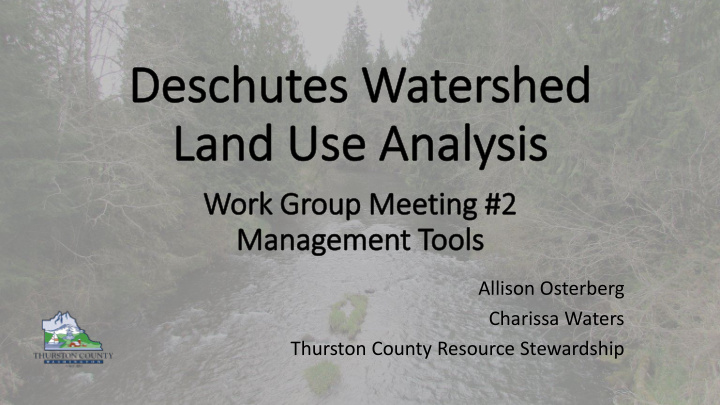



Allison Osterberg Charissa Waters Thurston County Resource Stewardship
Overview • Ground Rules • Review of Deschutes Current Conditions and Risks • Tools to Address Concerns • Regulatory • Voluntary
Ground Rules
Deschutes Current Conditions • Threats and Issues • Water Quality • Temperature, bacteria, sediment, nutrients • Future conditions • Population • Impervious surfaces • Wells • Septic systems • Farms • Forest cover
Deschutes Future Conditions • What management tools can we use to affect the future of the Deschutes watershed? • Regulatory tools • Voluntary tools
Zoning & Density • Zoning regulations determine how individual parcels of land can be used • Criteria set in County’s Comprehensive Plan • Density = dwelling units/acre • Rural zoning is generally anything < 1 unit/5 acres • Lower density zoning generally more protective
Critical Area Protections • Part of Comprehensive Plan Freshwater Riparian Type S (Deschutes) = 250 ft • CAO updated in 2012 Habitat Area Type F (Spurgeon, Silver, Reichel) = 150-250 ft • Critical Areas Wetland Buffers 50-300 ft • Fish & wildlife habitat areas • Wetlands • Critical aquifer recharge areas • Frequently flooded areas • Geologically hazardous areas (steep slopes)
Shoreline Management • Concerns area 200 feet Not in Shoreline landward of the Ordinary jurisdiction High Water Mark Not in Shoreline • Rivers over 20 cfs annual jurisdiction flow & floodway • Lakes 20 acres and larger • Associated wetlands • Most of Deschutes Study In Shoreline jurisdiction Area in “Conservancy” • 100 ft setback • Some lakes in “Rural” Being updated • 50 ft setback; 20 ft buffer now
Forest Practices • Class II, III DNR Forest Practices • Logging areas that will NOT be converted to another use* • Managed under State Forest Practices Act; Forests and Fish Law • Not subject to Critical Area Ordinance • Class IV • Logging area that will be developed • North County UGAs: area > 5,000 sq ft • Rural: 5,000 board feet • Subject to Critical Areas Ordinance • In Urban Growth Areas, 5% tree tract required
Development Regulations • Impervious Surface Limits • Set within zoning or overlay districts • Typical use on 5-acre parcel = 5% • Current limit RRR1/5, R1/10, R1/20 = 60% • Tree Preservation • No specific requirements outside of critical area protections or forest practices • Regulations only affect new development
Septic Systems • Septic systems can fail • Surveys from Henderson, Nisqually, Eld Inlet, Summit Lake • 14-33% failure rate • Time of Transfer • Septic systems must be inspected and repaired when property is sold • Operation & Maintenance • Voluntary programs: 30% participation rate • Henderson Inlet, mandatory: after 5 years, 3% failure rate
Sewer • GMA: urban services, like sewer lines not allowed outside urban boundaries • Rainier • Groundwater contamination concerns • Sewer line would allow/encourage more dense development • Commercial • Residential
Stormwater • County-wide stormwater utility • New development must meet state-regulated standards • Stormwater retrofits • Provide treatment or flow control for older development • Constructed wetlands • Bioretention swales
Enforcement • Limited resources • Complaint-driven
Questions?
Recommend
More recommend